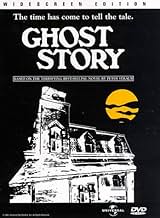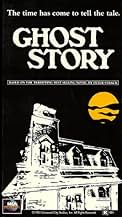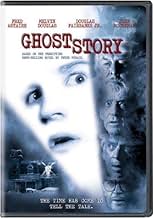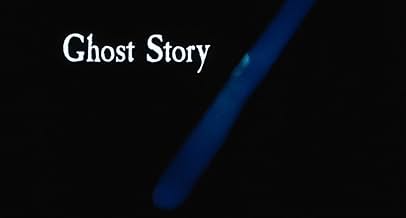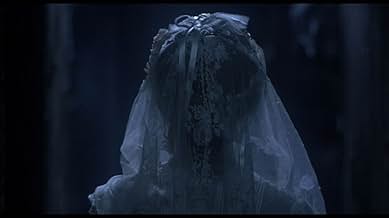NOTE IMDb
6,3/10
11 k
MA NOTE
Une série de morts mystérieuses révèle la mauvaise conscience de quatre notables d'une petite ville du Vermont. Ces derniers ont provoqué la mort d'une ravissante jeune femme qui s'est noyée... Tout lireUne série de morts mystérieuses révèle la mauvaise conscience de quatre notables d'une petite ville du Vermont. Ces derniers ont provoqué la mort d'une ravissante jeune femme qui s'est noyée quelques années auparavant.Une série de morts mystérieuses révèle la mauvaise conscience de quatre notables d'une petite ville du Vermont. Ces derniers ont provoqué la mort d'une ravissante jeune femme qui s'est noyée quelques années auparavant.
- Réalisation
- Scénario
- Casting principal
- Récompenses
- 3 nominations au total
Avis à la une
A condensing of Peter Straubs' more complex, more intriguing novel, the film adaptation is no great shakes but it's certainly not bad at all either. It does have the appeal of a spooky yarn one might spin by a fireplace in the dead of winter. The simplified story deals with four elderly New England gentlemen who get together and tell horror stories, but who in fact share a tragedy from their long-ago past. Now a revenge-minded spirit is out to make their lives miserable - and strike out at the two sons of one of them, to boot. The film does speak of quality - Jack Cardiff did the cinematography, Albert Whitlock and his team supply some beautiful matte shots, Philippe Sarde composed the stirring music score, and Dick Smith creates the plentiful hideous apparition effects - but the powerful main attraction is the assemblage of talent in the four main roles - Fred Astaire, Melvyn Douglas, Douglas Fairbanks Jr., and John Houseman - who are a delight, although Fairbanks exits the story much too soon. Craig Wasson plays the twin sons, and is likable as usual and manages to hold his own opposite his legendary co-stars. Patricia Neal is utterly wasted as Astaires' wife, but making up for that is the showcase given to the beautiful South African actress Alice Krige, who's extremely alluring and enigmatic as the mystery woman to whom both sons become attracted. There's a real sexual charge in her scenes with Wasson. This is one element that may concern some viewers, when they think about Astaire, Douglas, Fairbanks, and Houseman acting in a film that has violence and nudity (male as well as female), but for other horror fans a sufficient amount of atmosphere is built up and there are definitely some memorable scenes. Things are sometimes told in a flashback style, as first Wasson tells of his association with the not-so-subtly creepy Krige, or Astaire and Houseman finally break down and tell Wasson their whole sordid story. Overall, it's just compelling enough to work, and it does have some mighty fine moments, especially an iconic one involving a lake and a sinking car. It manages to be pretty eerie on a fairly consistent basis if never very scary. It marked the final feature film appearance for Astaire, Fairbanks, and Douglas. Seven out of 10.
"Ghost Story" charts two generations of men who find themselves being stalked by the vengeful spirit of a woman, hellbent on revenge against four elderly New England plutocrats who share a fifty year-old secret. When one of the men's sons returns to town after his brother's mysterious death, they are forced to unravel the story behind her.
Based on Peter Straub's wildly successful novel, "Ghost Story" came about during the peak of the slasher film and is one of the few remembered supernatural horror films of the eighties. Straub's source novel is probably one of the greatest American ghost novels ever written, and some people have found the adaptation unforgivable, as it does excise a great deal from the book; I personally am able to get past this.
What "Ghost Story" really is is a dark drama with a splash of horror, and this also has been a point of contention for genre fans. The film moves at a leisurely pace, and the scares are few and far between, but what director John Irvin does supply the audience is a profound atmosphere and general sense of weirdness that is unforgettable. The wintry Vermont landscape, the stuffy drawing rooms of the old men, and the abandoned mansion on the hill all provide a somber and pastoral backdrop that lend to the film's icy old-fashioned feel, and comparisons to "The Woman in Black" are well-earned.
The cast is one of the major selling points here: Fred Astaire, Melvyn Douglas, Douglas Fairbanks, John Houseman, and Patricia Neal round out a roster of classic Hollywood stars in their old age (for many, this was their last film). Craig Wasson plays two roles of the second generation, with Alice Krige as the haunting woman that runs between them. The acting is solid overall, though some of the older cast feel a bit underused; I think that may have to do with some wonky editing in the film, which is one of its few downfalls. It also feels dated at times, though not to its detriment.
Overall, "Ghost Story" is no less a well-made film with a classic, ghastly edge to it. It is a slow film in many ways, but the subtlety employed here combined with the bleak and picturesque New England winterland really made this an enjoyable experience. There are some phenomenal Gothic images throughout, and the story itself has a certain timelessness to it in spite of the film's more dated qualities. Memorable and atmospheric for a variety of reasons. 8/10.
Based on Peter Straub's wildly successful novel, "Ghost Story" came about during the peak of the slasher film and is one of the few remembered supernatural horror films of the eighties. Straub's source novel is probably one of the greatest American ghost novels ever written, and some people have found the adaptation unforgivable, as it does excise a great deal from the book; I personally am able to get past this.
What "Ghost Story" really is is a dark drama with a splash of horror, and this also has been a point of contention for genre fans. The film moves at a leisurely pace, and the scares are few and far between, but what director John Irvin does supply the audience is a profound atmosphere and general sense of weirdness that is unforgettable. The wintry Vermont landscape, the stuffy drawing rooms of the old men, and the abandoned mansion on the hill all provide a somber and pastoral backdrop that lend to the film's icy old-fashioned feel, and comparisons to "The Woman in Black" are well-earned.
The cast is one of the major selling points here: Fred Astaire, Melvyn Douglas, Douglas Fairbanks, John Houseman, and Patricia Neal round out a roster of classic Hollywood stars in their old age (for many, this was their last film). Craig Wasson plays two roles of the second generation, with Alice Krige as the haunting woman that runs between them. The acting is solid overall, though some of the older cast feel a bit underused; I think that may have to do with some wonky editing in the film, which is one of its few downfalls. It also feels dated at times, though not to its detriment.
Overall, "Ghost Story" is no less a well-made film with a classic, ghastly edge to it. It is a slow film in many ways, but the subtlety employed here combined with the bleak and picturesque New England winterland really made this an enjoyable experience. There are some phenomenal Gothic images throughout, and the story itself has a certain timelessness to it in spite of the film's more dated qualities. Memorable and atmospheric for a variety of reasons. 8/10.
I read Peter Straub's book and was quite pleased with the result of the movie. First of all, like many, I loved the cast. They are all great men of the world cinema and the pull off the story with great aplomb. The movie is about something someone does in his or her youth and then must live with forever. In a good ghost story, the characters get no points for being once youthful and reckless. The fact that they meet and share their stories means that they never seem to intend closure. They never allow themselves to face the music and, hence, the revenge of the spirit is acceptable in the world where they find themselves. I just thought that a society devoted to the telling of ghost stories was a great idea. Anyway, while the plot does wander around a bit and it takes time to get to the point, it still works great. It was nice to see that Fred Astaire could still act (because he was such a great dancer we forget that he had a great comic talent and, in this case, a dramatic talent). The others are equally formidable. There are also some pretty slimy, putrid visions that appear and make for a pretty good rank on the jump scale. The actually scene that explains everything (I won't spoil it) is both sad and revealing. While not the greatest movie, it works very well and I would recommend it.
... with a fantastic cast of veterans - Fred Astaire, John Houseman, Melvyn Douglas, Douglas Fairbanks Jr, and Patricia Neal. Unfortunately, the film always keeps getting in the way, leaving the veterans with scant onscreen attention.
The tale concerns a group of men, haunted by a death they were all accidentally responsible for in the early 1930s, and what happens when the ghost of that victim (Alice Krige) returns for vengeance, resulting in a lot of men shocked to death and abrupt shock cuts that show a rotting corpse in place of Krige's face. Unfortunately, maybe because of studio interference, the majority of screentime goes to Craig Wasson as a pair of Fairbanks' identical twin sons, one ill-fated very early on, the other more successful in surviving. Frankly put, although he isn't bad in the film, it feels like false advertising. (Wasson also has to have one of the tackiest death scenes in cinema history as the ill-fated brother who, terrified by Krige's skeletal look after a night of sex, plunges backwards stark naked from a high-rise window, as the film shows him against a badly processed back projection flailing his arms about, while his private parts flutters every which way like a Planters peanut caught in a strong wind). There's a reason Krige goes after the next generation in the case of Fairbanks' sons, but you'll have to watch and find out what that reason is.
So, Astaire and all the others I came to see are left with mere onscreen scraps, and are left with unformed characterizations. That feels like a grave betrayal for this classic film fan, especially in the light that it was the final film for Astaire, Douglas, and Fairbanks.
There were some particularly well-done parts though. For one Alice Krige was perfect for her part because her porcelain doll looks make her appear to be somebody out of an earlier time. Winter in the New England town the veteran actors live in has the look of a place that's haunted - it's very atmospheric. And finally, the film points out how having a crisis at 20 rather than 30 makes all the difference in the world as to the calmness and wisdom with which that crisis is handled.
The tale concerns a group of men, haunted by a death they were all accidentally responsible for in the early 1930s, and what happens when the ghost of that victim (Alice Krige) returns for vengeance, resulting in a lot of men shocked to death and abrupt shock cuts that show a rotting corpse in place of Krige's face. Unfortunately, maybe because of studio interference, the majority of screentime goes to Craig Wasson as a pair of Fairbanks' identical twin sons, one ill-fated very early on, the other more successful in surviving. Frankly put, although he isn't bad in the film, it feels like false advertising. (Wasson also has to have one of the tackiest death scenes in cinema history as the ill-fated brother who, terrified by Krige's skeletal look after a night of sex, plunges backwards stark naked from a high-rise window, as the film shows him against a badly processed back projection flailing his arms about, while his private parts flutters every which way like a Planters peanut caught in a strong wind). There's a reason Krige goes after the next generation in the case of Fairbanks' sons, but you'll have to watch and find out what that reason is.
So, Astaire and all the others I came to see are left with mere onscreen scraps, and are left with unformed characterizations. That feels like a grave betrayal for this classic film fan, especially in the light that it was the final film for Astaire, Douglas, and Fairbanks.
There were some particularly well-done parts though. For one Alice Krige was perfect for her part because her porcelain doll looks make her appear to be somebody out of an earlier time. Winter in the New England town the veteran actors live in has the look of a place that's haunted - it's very atmospheric. And finally, the film points out how having a crisis at 20 rather than 30 makes all the difference in the world as to the calmness and wisdom with which that crisis is handled.
I watched this film with a friend who described it as `one of the scariest movies he had ever seen.' I will agree with this assessment because the thrills are not cheap ones they are genuine scares. Ghost Story stars Fred Astaire, John Houseman, Douglas Fairbanks Jr. and Melvyn Douglas as members of the `Chowder Society' a group that gathers around the fireplace to drink brandy and tell ghost stories. The problem lies in the fact that they also share a long-kept secret that is now coming back to haunt them.
While it was novel to see these great actors in action, particularly in a genre where they are not normally known, this film is great because it does not rely on gore or special effects to scare the pants off the viewer. The horrors come from lower scale thrill, like a spooky house, an eerie soundtrack and quick flashes of horrific images that are sudden and impactful enough to make your heart leap into your throat.
This is a small, fun movie that isn't without its faults; (you can see the `secret' coming from a mile away) but the buildup to the unveiling of this secret is pure fun.
--Shelly
While it was novel to see these great actors in action, particularly in a genre where they are not normally known, this film is great because it does not rely on gore or special effects to scare the pants off the viewer. The horrors come from lower scale thrill, like a spooky house, an eerie soundtrack and quick flashes of horrific images that are sudden and impactful enough to make your heart leap into your throat.
This is a small, fun movie that isn't without its faults; (you can see the `secret' coming from a mile away) but the buildup to the unveiling of this secret is pure fun.
--Shelly
Le saviez-vous
- AnecdotesFinal theatrical feature film of veteran actors Melvyn Douglas, Fred Astaire, and Douglas Fairbanks Jr.
- GaffesRobert Burr is credited as " Principal ". Since the school in the film is a college, his title in the credits should be " Dean ".
- Versions alternativesThe Australian theatrical version was cut to receive a more commercial 'M' rating (all ages admitted but recommend for 15 and over) rather then an 'R' rating (restricted to 18 years and over).
- Bandes originalesSweetheart of Sigma Chi
Written by F. Dudleigh Vernor and Byron D. Stokes
Performed by Guy Lombardo and The Royal Canadians (as His Royal Canadians)
Meilleurs choix
Connectez-vous pour évaluer et suivre la liste de favoris afin de recevoir des recommandations personnalisées
Détails
Box-office
- Budget
- 13 500 000 $US (estimé)
- Montant brut aux États-Unis et au Canada
- 23 371 905 $US
- Week-end de sortie aux États-Unis et au Canada
- 2 105 729 $US
- 20 déc. 1981
- Montant brut mondial
- 23 371 905 $US
- Durée
- 1h 50min(110 min)
- Mixage
- Rapport de forme
- 1.33 : 1(original ratio, open matte)
Contribuer à cette page
Suggérer une modification ou ajouter du contenu manquant





